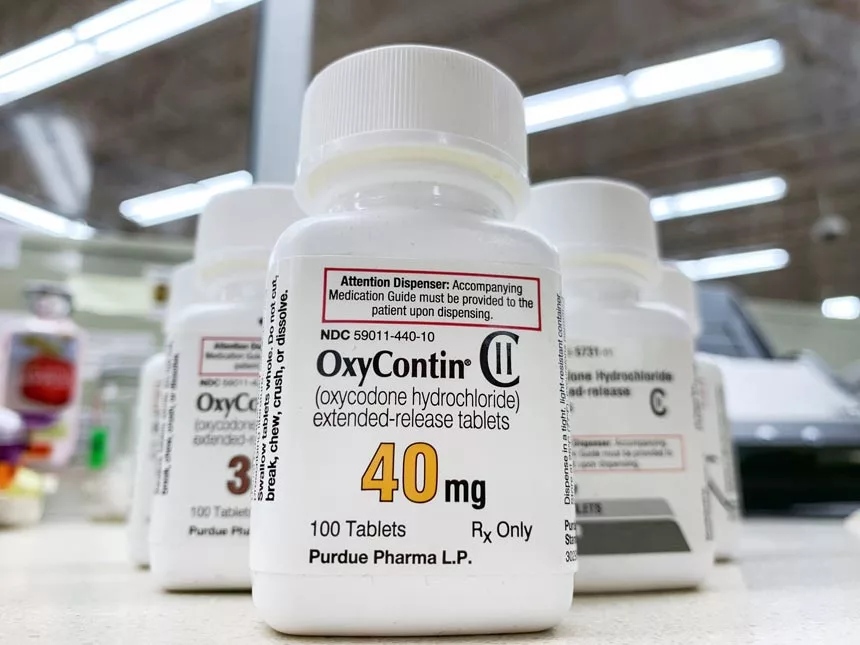What is OxyContin?
Table of Contents
- What is OxyContin?
- The Use of OxyContin and Other Prescription Opioids for Treating Chronic Pain
- OxyContin Forms and Methods of Use
- Why Is OxyContin So Addictive?
- How Does Someone Develop Habits of OxyContin Abuse?
- Understanding OxyContin Addiction
- Recognizing the Signs of Drug Abuse
- How Can I Help Someone With an Opioid Use Disorder?
- What are the Risk Factors for Developing an Opioid Addiction?
- The Side Effects of OxyContin Abuse
- Is it Possible to Overdose on OxyContin?
- How is an Opioid Addiction Treated?
- The Importance of Medical Detox in Treating Opioid Abuse
- Finding OxyContin Addiction Treatment Services
OxyContin (Oxycodone), or “Hillbilly Heroin,” is one of the most frequently abused prescription opioids used for treating acute pain. In particular, it has been deemed a miracle drug for cancer pain management; although it can be used for chronic non-cancer pain, as well.
While this prescription painkiller can be highly effective compared to other pain medications, it is one of the least commonly prescribed opioids. This is because OxyContin poses a major risk for substance abuse, a trait that is shared by most other opioid medications. As a result, OxyContin addiction is quite common among regular users of the drug.
According to the Drug Enforcement Administration (DEA), OxyContin is currently considered a Schedule II controlled substance. This means that, while it has an accepted medical purpose, it is considered to be a highly addictive and dangerous drug.
The Use of OxyContin and Other Prescription Opioids for Treating Chronic Pain
Opioid analgesics are drugs that are synthesized to create feelings similar to Morphine, directly impacting the central nervous system by binding with opioid receptors in the brain. When this interaction occurs, endorphins are released, producing feelings of euphoria and relaxation.
This is why prescribing opioids as severe pain relievers can be more effective than other drugs, as these are manufactured to be extremely powerful.
However, while prescription opioid medications can be particularly helpful in this aspect, these euphoric effects are also what makes them so prone to drug abuse. Thus, prescription opioids are typically only administered in small doses, and for brief periods of time.
OxyContin Forms and Methods of Use

Oxycodone generally comes in a round, colored pill form. The varying colors are used to identify the strength of the drug, with white representing 10 mg doses, pink being Oxy 20’s, brown as 30 mg, yellow as Oxy 40’s, green as 80 mg, and blue as 160 mg.
When this opioid use is carried out as prescribed, these pills are taken orally, with their effects lasting up to 12 hours. This is what makes them so effective in treating chronic pain.
Oxycodone is manufactured with a time-release mechanism, which is what allows its effects to be long-lasting. However, many users have devised ways to tamper with this time-release coating.
Once destroyed, these can be crushed into a powder, which is then snorted or dissolved into a liquid base and injected. This method of opioid misuse can produce a high very similar to Heroin, with side effects just as dangerous as this illicit substance.
Why Is OxyContin So Addictive?
The addictive characteristics of Oxycodone will generally depend on the user themselves. The most common start to this addiction typically begins with a prescription for the substance, leading many to feel that they need the medication to get through day-to-day life.
As Oxycodone acts similarly to Heroin, users who are seeking an escape from the emotional pain of their realities seek out the medication for its euphoric and sedative effects. Similar to other opioids, OxyContin rewires the brain’s priority of needs.
This drug makes itself a top priority, far above morals, responsibilities, and even other basic survival needs. Someone with severe habits of OxyContin abuse will eventually develop a tolerance to this prescription opioid.
Not only will this result in their body becoming physically and psychologically dependent on Oxycodone, but the continuous need to increase the frequency and dosage of their opioid use will also increase their risk of overdose.
The Spread of the U.S. Opioid Epidemic
Unfortunately, both illicit and prescription drug abuse is becoming increasingly prevalent within the United States. When discussing this public health crisis, it is impossible not to acknowledge the role opioids play in the drug epidemic currently wracking the nation.
According to the Centers for Disease Control and Prevention (CDC), over 70% of the 70,630 drug overdose deaths that occurred in 2019 were linked to opioids.
These rising cases of both illegal and prescription opioid abuse reveals, more than ever, the necessity to increase substance abuse awareness and preventative measures for addiction within this country.
How Does Someone Develop Habits of OxyContin Abuse?
The body naturally releases endorphins, and when opioids such as OxyContin are abused, the brain starts to “burn out”, causing a lack of naturally occurring endorphins. This causes the user feel the need to seek more, or risk falling into physical pain and mental anguish.
Some of the most commonly abused prescription Opioids, alongside OxyContin, are:
Understanding OxyContin Addiction
Without a doubt, OxyContin is one of the most addictive narcotics, even compared to other opioids. This remains the case even for those with a prescription for this opioid. When initially prescribed the drug, many users feel like they can function as if their pain never existed.
Prior to being prescribed OxyCodone, these individuals may not have been able to work, move, or live life without experiencing severe pain. Thus, having to give up this newly-found freedom after only a brief period experiencing it can feel impossible.
Unfortunately, these users will build a tolerance to OxyCodone over time, becoming physically dependent upon this medication to continue functioning normally. More often than not, eventually, a doctor will cease prescribing the medication once abuse begins.
This leads many to seek Oxycodone on the street or resort to using illicit opioids, such as seen in several cases of Heroin use. They may also invest large sums of money to continue their specific opioid use, as outsourced OxyContin can cost up to $50 a pill.
This may also lead to these individuals running into several legal problems, as they become desperate to feed their addiction by whatever means possible.
Recognizing the Signs of Drug Abuse
It can be hard to admit if you or a loved one is struggling with opioid addiction. However, OxyContin abuse can be a potentially life-threatening form of substance abuse, and may lead to other forms of addiction over time.
Thus, acknowledging that there is a problem is the first, and most critical step in being able to overcome this addiction. There are several signs that may indicate if someone is struggling with an Oxycodone use disorder, including:
- Taking Oxycodone in larger amounts or for longer periods of time than originally intended.
- Obtaining multiple Oxycodone prescriptions from several different doctors, or “doctor shopping,” in order to increase drug supply.
- Repeatedly unsuccessful attempts to cut down or stop Oxycodone use, even if there is a genuine desire to do so.
- Spending large amounts of time and money acquiring, using, or recovering from the effects of Oxycodone.
- Experiencing strong drug cravings when not using Oxycodone.
- Repeatedly being unable to fulfill major work, school, or home responsibilities and roles due to Oxycodone use.
- Continuing to use Oxycodone despite this causing persistent problems with friends, family members, or other social relationships.
- Giving up previously enjoyable activities or relationships in order to continue using Oxycodone.
- Using Oxycodone even in situations that could be potentially hazardous to oneself or others, such as driving, operating heavy machinery, or otherwise.
- Continuing to use Oxycodone despite this worsening or causing other mental and physical health conditions.
- Needing to use Oxycodone in larger doses or more frequently in order to achieve a desired effect.
- Experiencing symptoms of withdrawal when not using Oxycodone.
How Can I Help Someone With an Opioid Use Disorder?
The damage caused by addiction does not just affect an addicted individual; their loved ones often suffer just as much, if not more, from the habits of this person. While the user is of course suffering, having to witness a loved one’s descent into addiction can be debilitating.
Many users of the drug lose sight of their morals, responsibilities, and relationships to focus on obtaining and using the substance. As the user falls further into addiction, their friends’ may try to intervene, causing the user to feel guilt or shame, and in turn push their loved ones away.
Furthermore, as the drug takes hold on a user’s mind, many resort to stealing from their family and friends to fund their habits. While you may want to intervene yourself, the safest way to help an addicted loved one is to seek a professional interventionist.
These trained specialists can help facilitate a safe and support intervention environment, without the potential influence of any negative emotions from their hurt loved ones. With this professional support, the user can find their way to recovery, and back to themselves.
What are the Risk Factors for Developing an Opioid Addiction?
When addiction is mentioned, many have thoughts of someone on the street, having lost everything. While this is a very accurate depiction of what can happen overtime, it almost never starts out that way.
Drug addiction of any type does not discriminate; however, there are some risk factors that may increase an individual’s risk of developing certain substance use disorders. When it comes to Oxycodone, this is just as true.
This medication is frequently prescribed to and eventually abused by those struggling with persistent pain, such as elderly individuals, cancer patients, athletes, celebrities, or other individuals with demanding careers.
Another potential fallout of having prescription opiates is for those with children, as they may take it and distribute it among their friends at school. This is even more likely for those living in unstable or negative home environments, or who have family histories of addiction.
Individuals who may be struggling with mental health disorders may also have a higher risk of turning to substance use as a means of self-medicating their negative thoughts and emotions.
The Side Effects of OxyContin Abuse
Someone who is regularly abusing OxyContin may experience several adverse side effects. Short-term misuse of this substance may lead to:
- Impaired coordination
- Trouble Concentrating
- Confusion and disorientation
- Poor judgment and decision-making skills
For those who have a full-blown OxyContin addiction, more long-term side effects that may develop include:
- Tremors
- Bloodshot eyes
- Organ damage
- Poor personal hygiene
- Differences in sleeping habits
- Changed eating habits
- Altered perceptions of reality
- Low motivation
- Emotional detachment
- Increased irritability and agitation
- Depression
- Anxiety
Is it Possible to Overdose on OxyContin?
Individuals who take too large a dose of Oxycodone, or who use it several times within a short period of time, may be at a risk of overdosing. It is important to know how to recognize the symptoms of OxyContin overdose, as this can lead to death if left untreated.
This risk is also further increased in those who have been mixing Oxycodone with other substances.
Opioid Overdose Symptoms
As discussed, it is crucial to be able to recognize the signs of opioid overdose, particularly in the case of OxyContin. Fortunately, there are several overdose effects that may indicate that someone has taken too much of this substance, including:
- Excessive sweating
- Cold, clammy skin
- Shallow breathing
- Respiratory depression
- Low heart rate
- Blurry vision
- Pinpoint pupils
- Confusion and disorientation
- Seizure
- Drowsiness
- Loss of consciousness
How is an Opioid Addiction Treated?
Because of the extreme risks associated with this form of substance abuse, there are several addiction treatment options available to those struggling with an opioid use disorder.
Each person will have their own personal care needs for treating their addiction. However, there are a few general levels of care that will likely go into treating an OxyContin addiction. These include medical detox programs, as well as inpatient and outpatient treatment options.
For those who are struggling with co-occurring disorders, a supervised detox paired with inpatient programs that specialize in dual diagnosis treatment will likely be the best option for a successful recovery.
If you are unsure of what level of substance abuse treatment is right for you, speaking with a healthcare provider or addiction specialist can help you narrow down these options. Or, call the Find Addiction Rehabs hotline today to get help with all your recovery questions and concerns!
The Importance of Medical Detox in Treating Opioid Abuse

Medical detox programs are a key element in treating several types of addiction. However, they are particularly important for treating benzodiazepine, alcohol, and opioid use disorders. This is because these withdrawal periods can be extremely difficult, and even life-threatening.
By participating in a medically-supervised detox program, individuals can be gradually weaned off of OxyContin in a clinically controlled and supportive environment. This can help manage and even prevent certain withdrawal symptoms from occurring.
This process may also include medication-assisted treatment, in which individuals are administered controlled addiction medicines that can help prevent drug cravings and further decrease their risk of relapse.
OxyContin Withdrawal Symptoms
While different individuals may have different experiences while withdrawing from an abused opioid, this period will typically follow a general timeline. Early symptoms will often develop within the first 24 hours after a person’s last dose of OxyContin, and may include:
- Muscle aches
- Restlessness
- Anxiety
- Watery eyes
- Runny nose
- Excessive sweating
- Difficulty sleeping
- Excessive yawning
After a few days, these symptoms will typically start to become more intense, and may include:
- Abdominal cramping and diarrhea
- Chills
- Nausea and vomiting
- Dilated pupils
- Blurry vision
- Rapid heart rate
- High blood pressure
- Mood swings
Furthermore, individuals may experience behavioral symptoms, such as increased anxiety, depression, and suicidal ideations. Because these symptoms can be extremely difficult to endure, many individuals will relapse when attempting to detox on their own.
This is why it is always strongly recommended to seek out professional addiction treatment options, in order to ensure that you have the best chance at a successful recovery and achieving long-term sobriety.
Finding OxyContin Addiction Treatment Services
At Find Addiction Rehabs, we understand how painful it can be when you or a loved one is struggling with addiction; but that’s why we’re here. We are dedicated to connecting people like you with substance abuse treatment centers and services that provide all of your care needs.
With our hotline available 24/7, we are always here to provide addiction recovery resources and support, anytime you need it. So don’t wait; call now, and let us help you take the first step on your path to achieving a happier, healthier, and sober you, today!
Nicole R. is an experienced and accomplished writer with special interests in the fields of Anthropology, English, and behavioral health, and has written countless articles for newspaper publications, institutional research journals, and Find Addiction Rehabs.
Her alma matter is Florida Atlantic University in Boca Raton. Nicole hopes to spread awareness of and combat the stigmatization surrounding addiction and substance abuse treatment through her writing and work in the field.


